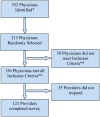Identifying human papillomavirus vaccination practices among primary care providers of minority, low-income and immigrant patient populations
- PMID: 24886959
- PMCID: PMC4107630
- DOI: 10.1016/j.vaccine.2014.05.058
Identifying human papillomavirus vaccination practices among primary care providers of minority, low-income and immigrant patient populations
Abstract
Objective: Minority populations in the United States are disproportionally affected by human papillomavirus (HPV) infection and HPV-related cancer. We sought to understand physician practices, knowledge and beliefs that affect utilization of the HPV vaccine in primary care settings serving large minority populations in areas with increased rates of HPV-related cancer.
Study design: Cross-sectional survey of randomly selected primary care providers, including pediatricians, family practice physicians and internists, serving large minority populations in Brooklyn, N.Y. and in areas with higher than average cervical cancer rates.
Results: Of 156 physicians randomly selected, 121 eligible providers responded to the survey; 64% were pediatricians, 19% were internists and 17% were family practitioners. Thirty-four percent of respondents reported that they routinely offered HPV vaccine to their eligible patients. Seventy percent of physicians reported that the lack of preventive care visits for patients in the eligible age group limited their ability to recommend the HPV vaccine and 70% of those who reported this barrier do not routinely recommend HPV vaccine. The lack of time to educate parents about the HPV vaccine and cost of the vaccine to their patients were two commonly reported barriers that affected whether providers offered the vaccine.
Conclusions: Our study found that the majority of providers serving the highest risk populations for HPV infection and HPV-related cancers are not routinely recommending the HPV vaccine to their patients. Reasons for providers' failure to recommend the HPV vaccine routinely are identified and possible areas for targeted interventions to increase HPV vaccination rates are discussed.
Keywords: HPV vaccine and primary care providers; HPV vaccine barriers; Human papillomavirus vaccine.
Copyright © 2014 Elsevier Ltd. All rights reserved.
Conflict of interest statement
Figures

Similar articles
-
Primary care providers human papillomavirus vaccine recommendations for the medically underserved: a pilot study in U.S. Federally Qualified Health Centers.Vaccine. 2014 Sep 22;32(42):5432-5. doi: 10.1016/j.vaccine.2014.07.098. Epub 2014 Aug 12. Vaccine. 2014. PMID: 25131744 Free PMC article.
-
Recommend, but also Discuss: Different Patterns of Physician-Perceived Barriers to Discussing HPV Vaccination and Their Association with Vaccine Administration in 11-12 Year-Old Girls.Matern Child Health J. 2016 Dec;20(12):2539-2547. doi: 10.1007/s10995-016-2079-9. Matern Child Health J. 2016. PMID: 27473091
-
Providers' practice, recommendations and beliefs about HPV vaccination and their adherence to guidelines about the use of HPV testing, 2007 to 2010.Prev Med. 2016 Jun;87:128-131. doi: 10.1016/j.ypmed.2016.02.030. Epub 2016 Feb 26. Prev Med. 2016. PMID: 26921654 Free PMC article.
-
US Health Care Clinicians' Knowledge, Attitudes, and Practices Regarding Human Papillomavirus Vaccination: A Qualitative Systematic Review.Acad Pediatr. 2018 Mar;18(2S):S53-S65. doi: 10.1016/j.acap.2017.10.007. Acad Pediatr. 2018. PMID: 29502639 Free PMC article.
-
A systematic review of factors influencing human papillomavirus vaccination among immigrant parents in the United States.Health Care Women Int. 2019 Jun;40(6):696-718. doi: 10.1080/07399332.2017.1404064. Epub 2017 Dec 15. Health Care Women Int. 2019. PMID: 29161198
Cited by
-
Provider perspectives on multilevel barriers to HPV vaccination.Hum Vaccin Immunother. 2019;15(7-8):1784-1793. doi: 10.1080/21645515.2019.1581554. Epub 2019 Apr 11. Hum Vaccin Immunother. 2019. PMID: 30779687 Free PMC article.
-
Male Undergraduates' HPV Vaccination Behavior: Implications for Achieving HPV-Associated Cancer Equity.J Community Health. 2018 Jun;43(3):459-466. doi: 10.1007/s10900-018-0482-4. J Community Health. 2018. PMID: 29470802
-
Vaccine hesitancy among general practitioners: evaluation and comparison of their immunisation practice for themselves, their patients and their children.Eur J Clin Microbiol Infect Dis. 2016 Nov;35(11):1837-1843. doi: 10.1007/s10096-016-2735-4. Epub 2016 Aug 3. Eur J Clin Microbiol Infect Dis. 2016. PMID: 27488435
-
Barriers and determinants of consistent offering of HPV vaccination by healthcare facilities.Hum Vaccin Immunother. 2023 Aug;19(2):2264596. doi: 10.1080/21645515.2023.2264596. Epub 2023 Oct 17. Hum Vaccin Immunother. 2023. PMID: 37846730 Free PMC article.
-
Human papillomavirus infection and vaccination: Knowledge and attitudes among young males in Italy.Hum Vaccin Immunother. 2016 Jun 2;12(6):1504-10. doi: 10.1080/21645515.2016.1156271. Epub 2016 Apr 12. Hum Vaccin Immunother. 2016. PMID: 27070042 Free PMC article.
References
-
- CDC. Human Papillomavirus-Associated Cancers - United States, 2004-2008. Morbidity and Mortality Weekly Report. 2012;61:258–261. - PubMed
-
- CDC. FDA Licensure of Bivalent Human Papillomavirus Vaccine (HPV2, Cervarix) for Use in Females and Updated HPV Vaccination Recommendations from the Advisory Committee on Immunization Practices (ACIP) Morbidity and Mortality Weekly Report. 2010;59(20):626–629. - PubMed
-
- CDC. National and State Vaccination Coverage Among Adolescents Aged 13-17 Years ---United States, 2011. Morbidity and Mortality Weekly Report. 2012;61(34):671–677. - PubMed
-
- Dorell CG, Yankey D, Santibanez TA, Markowitz LE. Human papillomavirus vaccination series initiation and completion, 2008-2009. Pediatrics. 2011 Nov;128(5):830–839. - PubMed
Publication types
MeSH terms
Substances
Grants and funding
LinkOut - more resources
Full Text Sources
Other Literature Sources
Medical

